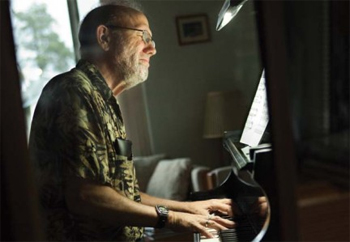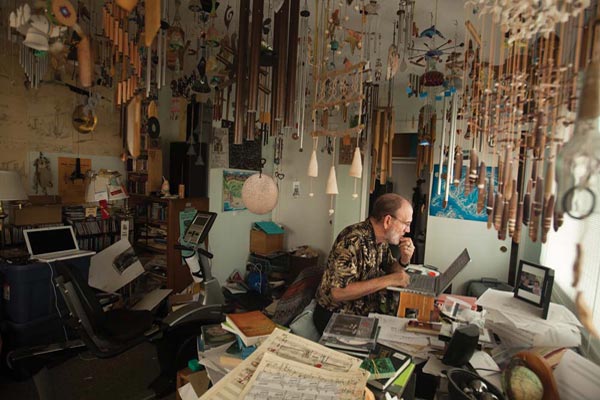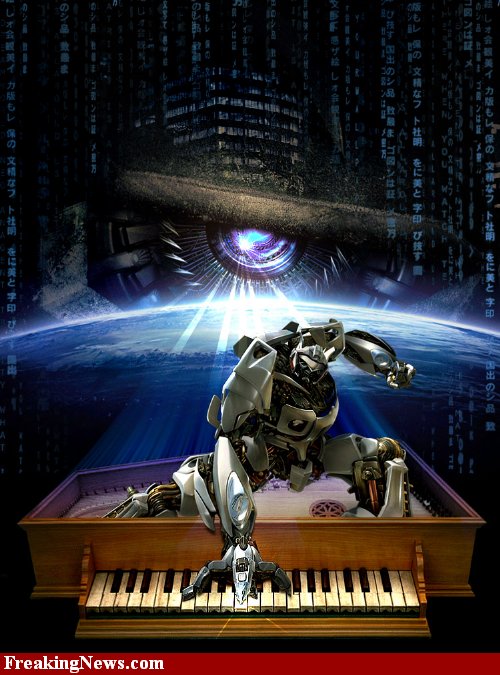Soulful Sounds from a Soulless Being: Triumph of the Cyborg Composer
Source: hplusmagazine.com
“Why not develop music in ways unknown? This only makes sense. I cannot understand the difference between my notes on paper and other notes on paper. If beauty is present, it is present. I hope I can continue to create notes and that these notes will have beauty for some others. I am not sad. I am not happy. I am Emily. You are Dave. Life and un-life exist. We coexist. I do not see problems.” —Emily Howell
Emily Howell’s philosophic musings and short Haiku-like sentences are the giveaway.
Emily Howell is the daughter program of Emmy (Experiments in Musical Intelligence — sometimes spelled EMI), a music composing program written by David Cope, Dickerson Emeriti Professor at the University of California, Santa Cruz. Emily Howell’s interesting ramblings about music are actually the result of a set of computer queries.
Her music, however, is something else again: completely original and hauntingly beautiful. Even a classical purist might have trouble determining whether a human being or an AI program created it. Judge for yourself:
Video from: YouTube.com
Cope is also Honorary Professor of Computer Science (CS) at Xiamen University in China. While he insists that he is a music professor first, he manages to leverage his knowledge of CS into some highly sophisticated AI programming. He characterizes Emily Howell in a recent NPR interview as “a computer program I’ve written in the computer programming language LISP. And it is a program which accepts both ASCII input, that is letters from the computer keyboard, as well as musical input, and it responds to me in a collaborative way as we compose together.” Emmy, Cope’s earlier AI system, was able to take a musical style — say, classical heavyweights such as Bach, Beethoven, or Mozart — and develop scores imitating them that classical music scholars could not distinguish from the originals.
The classical music aficionado is often caricatured as a highbrow nose-in-the-air, well… snob.
Classical music is frequently consigned by the purist to the past few centuries of European music (with the notable exceptions of American composers like Gershwin and Copeland). Even the experimental “new music” of human composers is often controversial to the classical music community as a whole.
Frank Zappa — a student of the avant-garde European composer Edgard Varèse and a serious classical composer in his own right — had trouble getting a fair listen to his later classical works (he was an irreverent rock-and-roll star after all!), even though his compositions broke polytonal rhythmic ground with complexity previously unheard in Western music.

UC Santa Cruz emeritus professor David Cope is ready to introduce computer software that creates original, modern music. (Catherine Karnow/miller-mccune.com)
Cope faced similar prejudices with his AI composer, Emmy, and was unable to find any big-name classical musicians who would even touch her work.
“Most musicians, academic or composers, have always held this idea that the creation of music is innately human, and somehow this computer program was a threat in some way to that unique human aspect of creation,” says Cope in an Ars Technica piece.
With Emily Howell, however, he has gone a step further than he did with Emmy. Rather that starting with works of the classical masters, Emily Howell uses Emmy’s output to create completely original compositions. Emily Howell is adaptable and egolessly self-modifying in her ability to respond to audience criticism. (Cope’s choice of names makes it easy to anthropomorphize “her.”)
She is able to take written or audio feedback and incorporate it into her next musical composition. Emily’s inner workings along with code samples are included in Cope’s 2005 book Computer Models of Musical Creativity.
Adaptability and self-modification are two attributes of intelligence. The Turing test was devised by Alan Turing as a way of authenticating machine intelligence. His well-known test involves a human judge communicating with both a computer and a human using a computer terminal. The judge must determine which is human and which is machine. The judge cannot see either the computer or the human and must make his or her determination by interviewing both. The computer attempts to convince the judge that it is human.
As Turing originally envisioned it, the computer tries to act like a human during the interview. Ray Kurzweil argues that a narrower concept of a Turing test is for a computer to successfully imitate a human within a particular domain of human intelligence, “We might call these domain-specific Turing tests,” says Kurzweil. Emily Howell falls into the category of a domain-specific Turing test, based on a computer’s ability to write entirely original music that even classical purists can’t always distinguish from human compositions.
Has Emily Howell passed the Turing Test? Put another way, can a computer become a truly creative independent agent within the narrow domain of music composition? Cope’s efforts have been praised by both musicians and computer scientists, but they disturb some. Emily Howell raises interesting questions about what it means to be human. If a machine can write a Bach invention, a Chopin mazurka, or a Mozart concerto that is indistinguishable from the original — an entirely original piece that fools even the classical aficionado — then who’s to say that Emily Howell hasn’t passed the Turing Test?
In Emily’s own words: “If beauty is present, it is present. I hope I can continue to create notes and that these notes will have beauty for some others.”
Emily Howell’s first CD is due out this month from Centaur Records.
Article from: HPlusMagazine.com
Triumph of the Cyborg Composer
By: Ryan Blitstein | www.Miller-McCune.com
David Cope’s software creates beautiful, original music. Why are people so angry about that?
The office looks like the aftermath of a surrealistic earthquake, as if David Cope’s brain has spewed out decades of memories all over the carpet, the door, the walls, even the ceiling. Books and papers, music scores and magazines are all strewn about in ragged piles. A semi-functional Apple Power Mac 7500 (discontinued April 1, 1996) sits in the corner, its lemon-lime monitor buzzing. Drawings filled with concepts for a never-constructed musical-radio-space telescope dominate half of one wall. Russian dolls and an exercise bike, not to mention random pieces from homemade board games, peek out from the intellectual rubble. Above, something like 200 sets of wind chimes from around the world hang, ringing oddly congruent melodies.
And in the center, the old University of California, Santa Cruz, emeritus professor reclines in his desk chair, black socks pulled up over his pants cuffs, a thin mustache and thick beard lending him the look of an Amish grandfather.
It was here, half a dozen years ago, that Cope put Emmy to sleep. She was just a software program, a jumble of code he’d originally dubbed Experiments in Musical Intelligence (EMI, hence “Emmy”). Still — though Cope struggles not to anthropomorphize her — he speaks of Emmy wistfully, as if she were a deceased child.
Emmy was once the world’s most advanced artificially intelligent composer, and because he’d managed to breathe a sort of life into her, he became a modern-day musical Dr. Frankenstein. She produced thousands of scores in the style of classical heavyweights, scores so impressive that classical music scholars failed to identify them as computer-created. Cope attracted praise from musicians and computer scientists, but his creation raised troubling questions: If a machine could write a Mozart sonata every bit as good as the originals, then what was so special about Mozart? And was there really any soul behind the great works, or were Beethoven and his ilk just clever mathematical manipulators of notes?
Cope’s answers — not much, and yes — made some people very angry. He was so often criticized for these views that colleagues nicknamed him “The Tin Man,” after the Wizard of Oz character without a heart. For a time, such condemnation fueled his creativity, but eventually, after years of hemming and hawing, Cope dragged Emmy into the trash folder.
This month, he is scheduled to unveil the results of a successor effort that’s already generating the controversy and high expectations that Emmy once drew. Dubbed “Emily Howell,” the daughter program aims to do what many said Emmy couldn’t: create original, modern music. Its compositions are innovative, unique and — according to some in the small community of listeners who’ve heard them performed live — superb.
Sample of Emily Howell — Track 1
Sample of Emily Howell — Track 2
With Emily Howell, Cope is, once again, challenging the assumptions of artists and philosophers, exposing revered composers as unknowing plagiarists and opening the door to a world of creative machines good enough to compete with human artists. But even Cope still wonders whether his decades of innovative, thought-provoking research have brought him any closer to his ultimate goal: composing an immortal, life-changing piece of music.
Cope’s earliest memory is looking up at the underside of a grand piano as his mother played. He began lessons at the age of 2, eventually picking up the cello and a range of other instruments, even building a few himself. The Cope family often played “the game” — his mother would put on a classical record, and the children would try to divine the period, the style, the composer and the name of works they’d read about but hadn’t heard. The music of masters like Rachmaninov and Stravinsky instilled in him a sense of awe and wonder.
Nothing, though, affected Cope like Tchaikovsky’s Romeo and Juliet, which he first heard around age 12. Its unconventional chord changes and awesome Sturm und Drang sound gave him goose bumps. From then on, he had only one goal: writing a piece that some day, somewhere, would move some child the same way Tchaikovsky moved him. “That, just simply, was the orgasm of my life,” Cope says.
He begged his parents to pay for the score, brought it home and translated it to piano; he studied intensely and bought theory books, divining, scientifically, what made it work. It was then he knew he had to become a composer.
Cope sailed through music schooling at Arizona State University and the University of Southern California, and by the mid-1970s, he had settled into a tenured position at Miami University of Ohio’s prestigious music department. His compositions were performed in Carnegie Hall and The Kennedy Center for the Performing Arts, and internationally from Lima, Peru, to Bialystok, Poland. He built a notable electronic music studio and toured the country, wowing academics with demonstrations of the then-new synthesizer. He was among the foremost academic authorities on the experimental compositions of the 1960s, a period during which a fired-up jet engine and sounds derived from placing electrodes on plants were considered music.

David Cope in his home office. (Catherine Karnow)
When Cope moved to UC Santa Cruz in 1977 to take a position in its music department, he could’ve put his career on autopilot and been remembered as a composer and author. Instead, a brutal case of composer’s block sent him on a different path.
In 1980, Cope was commissioned to write an opera. At the time, he and his wife, Mary (also a Santa Cruz music faculty member), were supporting four children, and they’d quickly spent the commission money on household essentials like food and clothes. But no matter what he tried, the right notes just wouldn’t come. He felt he’d lost all ability to make aesthetic judgments.
Terrified and desperate, Cope turned to computers.
Along with his work on synthesis, or using machines to create sounds, Cope had dabbled in the use of software to compose music. Inspired by the field of artificial intelligence, he thought there might be a way to create a virtual David Cope software to create new pieces in his style.
The effort fit into a long tradition of what would come to be called algorithmic composition. Algorithmic composers use a list of instructions — as opposed to sheer inspiration — to create their works. During the 18th century, Joseph Haydn and others created scores for a musical dice game called Musikalisches Würfelspiel, in which players rolled dice to determine which of 272 measures of music would be played in a certain order. More recently, 1950s-era University of Illinois researchers Lejaren Hiller and Leonard Isaacson programmed stylistic parameters into the Illiac computer to create the Illiac Suite, and Greek composer Iannis Xenakis used probability equations. Much of modern popular music is a sort of algorithm, with improvisation (think guitar solos) over the constraints of simple, prescribed chord structures.
Few of Cope’s major works, save a dalliance with Navajo-style compositions, had strayed far from classical music, so he wasn’t a likely candidate to rely on software to write. But he did have an engineer’s mind, composing using note-card outlines and a level of planning that’s rare among free-spirited musicians. He even claims to have created his first algorithmic composition in 1955, instigated by the singing of wind over guide wires on a radio tower.
Cope emptied Santa Cruz’s libraries of books on artificial intelligence, sat in on classes and slowly learned to program. He built simple rules-based software to replicate his own taste, but it didn’t take long before he realized the task was too difficult. He turned to a more realistic challenge: writing chorales (four-part vocal hymns) in the style of Johann Sebastian Bach, a childhood favorite.
After a year’s work, his program could compose chorales at the level of a C-student college sophomore. It was correctly following the rules, smoothly connecting chords, but it lacked vibrancy. As AI software, it was a minor triumph. As a method of producing creative music, it was awful.
Cope wrestled with the problem for months, almost giving up several times. And then one day, on the way to the drug store, Cope remembered that Bach wasn’t a machine — once in a while, he broke his rules for the sake of aesthetics. The program didn’t break any rules; Cope hadn’t asked it to.
The best way to replicate Bach’s process was for the software to derive his rules — both the standard techniques and the behavior of breaking them. Cope spent months converting 300 Bach chorales into a database, note by note. Then he wrote a program that segmented the bits into digital objects and reassembled them the way Bach tended to put them together.
The results were a great improvement. Yet as Cope tested the recombinating software on Bach, he noticed that the music would often wander and lacked an overall logic. More important, the output seemed to be missing some ineffable essence.
Again, Cope hit the books, hoping to discover research into what that something was. For hundreds of years, musicologists had analyzed the rules of composition at a superficial level. Yet few had explored the details of musical style; their descriptions of terms like “dynamic,” for example, were so vague as to be unprogrammable. So Cope developed his own types of musical phenomena to capture each composer’s tendencies — for instance, how often a series of notes shows up, or how a series may signal a change in key. He also classified chords, phrases and entire sections of a piece based on his own grammar of musical storytelling and tension and release: statement, preparation, extension, antecedent, consequent. The system is analogous to examining the way a piece of writing functions. For example, a word may be a noun in preparation for a verb, within a sentence meant to be a declarative statement, within a paragraph that’s a consequent near the conclusion of a piece.
Finally, Cope’s program could divine what made Bach sound like Bach and create music in that style. It broke rules just as Bach had broken them, and made the result sound musical. It was as if the software had somehow captured Bach’s spirit — and it performed just as well in producing new Mozart compositions and Shakespeare sonnets. One afternoon, a few years after he’d begun work on Emmy, Cope clicked a button and went out for a sandwich, and she spit out 5,000 beautiful, artificial Bach chorales, work that would’ve taken him several lifetimes to produce by hand.
When Emmy’s Bach pieces were first performed, at the University of Illinois at Urbana-Champaign in 1987, they were met with stunned silence. Two years later, a series of performances at the Santa Cruz Baroque Festival was panned by a music critic — two weeks before the performance. When Cope played “the game” in front of an audience, asking which pieces were real Bach and which were Emmy-written Bach, most people couldn’t tell the difference. Many were angry; few understood the point of the exercise.
Cope tried to get Emmy a recording contract, but classical record companies said, “We don’t do contemporary music,” and contemporary record companies said the opposite. When he finally did land a deal, no musician would play the music. He had to record it with a Disklavier (a modern player piano), a process so taxing he nearly suffered a nervous breakdown.
Though musicians and composers were often skeptical, Cope soon attracted worldwide notice, especially from scientists interested in artificial intelligence and the small, promising field called artificial creativity. Other “AC” researchers have written programs that paint pictures; that tell Mexican folk tales or write detective novels; and that come up with funny jokes. They have varying goals, though most seek to better understand human creativity by modeling it in a machine.
Read the full article at: www.Miller-McCune.com
Also tune into:
Kevin Warwick - Artificial Intelligence & The Rise of the Machines in 2020
John Lash - Artificial Technomania of the Archons
Michael Tsarion - The Post Human World
William Henry - Stargate Technology & Transhumanism
Jim Elvidge - The Singularity, Nanobot’s & Reality Simulation
Neil Hague - The Rise of the True Human Being, Art & Unlocking the Imagination
Freeman - Robo-Sapiens, Transfer of the Soul, Urantia Book & All Things Blue
Aaron Franz - TransAlchemy, Save the Humans!
Aaron Franz - Transhuman Fundamentalism
Kyle Hunt - The Gods of Technology
Kyle Hunt - The Gods of Technology Continued
Lenon Honor - The Borg Agenda & The Sexualization of Technology























